Hoklo people
_(14597338250).jpg) A Hokkien family in Fujian, 1920. | |
| Total population | |
|---|---|
|
Mainstream Hoklo Population : 56,118,000 [1] Greater Hoklo Population : Up to 100 million | |
| Regions with significant populations | |
|
Fujian Guangdong Hainan | |
| Majority of Han Taiwanese people (~16,321,075) | |
| Largest group of Malaysian Chinese (~2,020,000) | |
| Majority of Chinese Filipinos (~1,500,000)[2] | |
| Largest group of Chinese Singaporeans (~1,118,817) | |
| Largest group of Indonesian Chinese (~1,100,000)[3] | |
|
One of the 3 largest groups of Burmese Chinese (~720,000) (figured combined with Cantonese)[4] | |
| >70,000[5] | |
| A minority population | |
| A minority population | |
| A significant group among ethnic Sinoa | |
| Languages | |
|
Mainstream Tongue : Quanzhang Minnan Other Min Nan variants : Teochew, Leizhounese, Hainanese, Longyan Min, Zhenan Min, Zhongshan Min, Datian Min.
Diaspora also speak their respective country's language(s) | |
| Religion | |
|
Chinese folk religions (including Taoism, Confucianism, ancestral worship and others), Mahayana Buddhism and non-religious; minority: Christianity. | |
| Related ethnic groups | |
| Hoklo Taiwanese, Hoklo Americans, Putian people, Teochew people, Hainanese people Ancient Minyue people† and other Han Chinese | |
The Hoklo people are Han Chinese people whose traditional ancestral homes are in Fujian, South China. They are also known by various endonyms (Pe̍h-ōe-jī: Hok-ló-lâng/Hō-ló-lâng/Ho̍h-ló-lâng/Hô-ló-lâng), or other related terms such as Banlam (Minnan) people (閩南儂; Bân-lâm-lâng) or Hokkien people (福建儂; Hok-kiàn-lâng).
In the narrowest scope, "Hoklo people" refers mainly to people whose native dialect is the Quanzhang (Hokkien-Taiwanese) dialect of Min Nan Chinese spoken in Fujian, Taiwan, Malaysia, Singapore, Indonesia, the Philippines and by many overseas Chinese throughout Southeast Asia. In a wider scope, "Hoklo people" includes native speakers of other Min Nan variants, such as Zhongshan Min, Zhenan Min, Teochew dialect, and Hainanese.[6]
There have been many famous Hoklo people throughout history, notably Koxinga, Shi Lang, Corazon Aquino and Su Song.
Etymology
.jpg)
In Taiwan, there are three common ways to write Hoklo in Chinese characters (Hokkien pronunciations are given in Pe̍h-ōe-jī), although none have been established as etymologically correct:
- 福佬; Hok-ló; "Fujian folk" – emphasizes their connection to Fujian province. It is not an accurate transliteration in terms from Hokkien itself although it may correspond to an actual usage in Hakka.
- 河洛; Hô-lo̍k; "Yellow River and Luo River" – emphasizes their purported long history originating from the area south of the Yellow River. This term does not exist in Hokkien. The transliteration is a phonologically inaccurate folk etymology, though the Mandarin pronunciation Héluò has gained currency through the propagation of the inaccurate transliteration.
- 鶴佬; Ho̍h-ló; "crane folk" – emphasizes the modern pronunciation of the characters (without regard to the meaning of the Chinese characters); phonologically accurate.
Meanwhile, Hoklo people self-identify as 河老; Hô-ló; "river aged".[7]
In Hakka, Teochew, and Cantonese, Hoklo may be written as Hoglo (學老; "learned aged") and 學佬 ("learned folk").
Despite the many ways to write Hoklo in Chinese, the term Holo[8][9] (Hō-ló/Hô-ló)[10] is used in Taiwan to refer to the ethnicity and language (Taiwanese Hokkien).
Culture
Architecture

Hoklo architecture is for the most part similar to any other traditional Chinese architectural styles, Hoklo shrines and temples have tilted sharp eaves just like the architecture of Han Chinese in all parts of China due to superstitious beliefs, however Hoklo shrines and temples do have special differences from the styles in other regions of China: the top roofs are high and slanted with exaggerated finely-detailed decorative inlays of wood and porcelain.
The main halls of Hoklo temple are also a little different, they are usually decorated with two dragons on the rooftop at the furthest left and right corners, and a miniature figure of a pagoda at the centre rooftop. One such example of this is the Kaiyuan Temple in Fujian, China. Other than all these minor differences, Hoklo architecture is the basically same as any other traditional Chinese architecture of any other regions by Han Chinese.
Language
The Hoklo people speak the mainstream Minnan (Hokkien) dialect which is not mutually intelligble with other Chinese dialects except for Teochew dialect to a small degree. Minnan can be traced back to the Tang Dynasty, and it also has roots from earlier periods such as the Northern and Southern Dynasties and also a little influence from other dialects as well.
Hokkien has one of the most diverse phoneme inventories among Chinese varieties, with more consonants than Standard Mandarin or Cantonese. Vowels are more-or-less similar to that of Standard Mandarin. Hokkien varieties retain many pronunciations that are no longer found in other Chinese varieties. These include the retention of the /t/ initial, which is now /tʂ/ (Pinyin 'zh') in Mandarin (e.g. 'bamboo' 竹 is tik, but zhú in Mandarin), having disappeared before the 6th century in other Chinese varieties.[11] Hokkien has 5 to 7 tones or 7 to 9 tones according to traditional sense, depending on variety of hokkien spoken such as the Amoy dialect for example has 7-8 tones.
Diaspora
In Taiwan
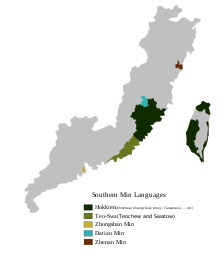
About 70% of the Taiwanese people descend from Hoklo immigrants who arrived to the island prior to the start of Japanese rule in 1895. They could be categorized as originating from Xiamen, Quanzhou and Zhangzhou based on their dialects and districts of origin.[12] People from the former two areas (Quanzhou-speaking) were dominant in the north of the island and along the west coast, whereas people from the latter two areas (Zhangzhou-speaking) were dominant in the south and perhaps the central plains as well.
Malaysia, Singapore, Indonesia and Philippines Hoklo or Hokkien-lang (Hokkien People)
The Hoklo or Hokkien-lang (as they are known in these countries) are the largest dialect group among the Malaysian Chinese, Singapore and southern part of Thailand. They constitute the highest concentrations of Hoklo or Hokkien-lang in the region. The various Hokkien dialects/Minnan are still widely spoken in these countries but the daily use are slowly decreasing in favor of Mandarin Chinese, English or local language.
The Hoklo or Hokkien-lang are also the largest group among the Chinese Indonesians . Most speak only Bahasa Indonesian.
In the Philippines, the Hoklo or Hokkien-lang form the majority of the Chinese people in the country. The Hokkien dialect/Minnan is still spoken there.
Haifeng, Lufeng and Leizhou in Guangdong, China
The people of Leizhou and non-Hakka people in Haifeng and Lufeng are Hoklo people, in a narrow scope, but are often mistaken as Chaozhou/Teochew people in Hong Kong and Southeast Asia.
North America
Between 1885 and 1949, there were only nine migrants out of nearly 100,000 to Canada who traced their origins to Fujian.[13]
After the 1960s, more Han Taiwanese Hoklo people began immigrating to the United States and Canada.
Notable People of Hoklo/Southern Min Origins
This list includes people who are of either pure or partial Hoklo/Southern Min patrilineal ancestry.
Academics, Mathematicians and Scientists
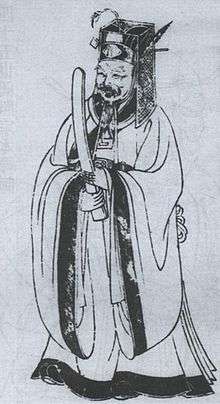 Su Song, Brilliant scientist and mathematician during the Song Dynasty.
Su Song, Brilliant scientist and mathematician during the Song Dynasty.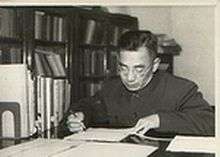 Lu Jiaxi, Child genius who finished elementary school in one year, enrolled in a university before even reaching 13 years old and obtained a chemistry degree at just age 18/19.
Lu Jiaxi, Child genius who finished elementary school in one year, enrolled in a university before even reaching 13 years old and obtained a chemistry degree at just age 18/19. Gu Hongming, Malayan-born Man of letters, President of the Nanyang Public School (forerunner of Jiao Tong University Shanghai) and Professor at Peking University in 1915.
Gu Hongming, Malayan-born Man of letters, President of the Nanyang Public School (forerunner of Jiao Tong University Shanghai) and Professor at Peking University in 1915.
- Su Song, Chinese scientist and mathematician during the Song Dynasty who invented the first hydro-mechanical astronomical clock and endless power chain drive in the world.
- Cai Qirui, father of Chinese catalytic chemistry.
- Lu Jiaxi, child prodigy who was so smart he finished elementary school in one year and enrolled in a university before reaching the age of 13. He received the Tan Kah Kee scholarship for four years and graduated from Xiamen University in 1934 with a degree in chemistry at age 18 or 19. Taught at the university for 3 years. President of the Chinese Academy of Sciences, Director of Fujian Institute of Research on the Structure of Matter (FJIRSM), and Vice President of Fuzhou University, as well as high-ranking political positions including Chairman of the Chinese Peasants' and Workers' Democratic Party, Vice Chairman of the Chinese People's Political Consultative Conference (CPPCC), and Vice Chairman of the National People's Congress.
- Xie Xide, physicist who made important contributions to the field of solid-state physics.[14] She also served as president of the Fudan University.
- Gu Hongming, Man of letters who was born in British Malaya, President of the Nanyang Public School (forerunner of Jiao Tong University Shanghai) and Professor at Peking University in 1915. Many sayings and anecdotes have been attributed to him, few of which can be attested. Literary figures as diverse as Ryūnosuke Akutagawa, Somerset Maugham and Rabindranath Tagore were all drawn to visit him when they were in China.
- Leon O. Chua, Philippine-born Inventor of the Chua's circuit. Also known for the Nonlinear circuit theory, Cellular neural networks, Memristor, Chaotic digital CDMA etc. Father of Amy Chua.
- Yuan T. Lee, Winner of Nobel prize in Chemistry for his outstanding contribution to Chemistry.[15]
- Zhijian James Chen, Famous biochemist best known for using classical biochemistry to discover new pathways and mechanisms in innate immunity and cell signaling such as Mitochondrial antiviral-signaling protein.
- Ma Yuehan Pioneer in physical education and modern Chinese sports. During his lifetime he was the Professor of Physical Education at the Tsinghua University for 52 years.
- Richard Yeo (scientist) - Chinese American scientist with 17 US patents.
- Fang Zhouzi, Postdoctoral researcher in molecular genetics, he obtained his Ph.D. in biochemistry in 1995. Aside from being a scientific researcher, he is also a science writer, a rwporter and is famous for campaigning against pseudoscience and various types of fraud in China.
- Pua Khein-Seng, Malaysian Chinese who is one of the inventors of the USB flash drive.
- March Tian Boedihardjo, child genius who finished his A-level exams in Britain at the age of nine years and three months and was conferred a Bachelor of Science in Mathematical Science as well as a Master of Philosophy in Mathematics after successfully completing his programme in 2011 (one year early).
Businessmen and Entrepreneurs
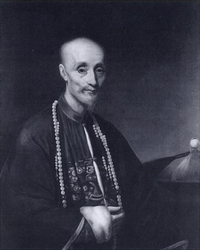 Howqua, once the world's richest man in 19th Century.
Howqua, once the world's richest man in 19th Century.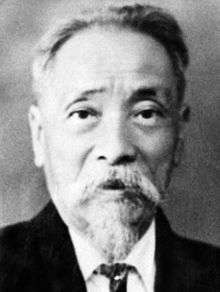 Ong Seok Kim Wealthy entrepreneur in colonial Malaya who raise and donated money to help the relief work for the various disasters and famines in China
Ong Seok Kim Wealthy entrepreneur in colonial Malaya who raise and donated money to help the relief work for the various disasters and famines in China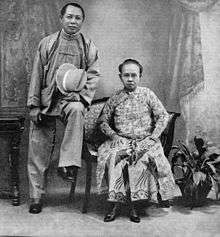 Lim Chin Tsong, Burmese Chinese tycoon who was known for his kindness and generosity among the Chinese community in Rangoon.
Lim Chin Tsong, Burmese Chinese tycoon who was known for his kindness and generosity among the Chinese community in Rangoon.
- Howqua (the Second) or Wu Bingjian, China's richest man in the 19th Century. Single-handedly contributed one million dollars, one third of the total sum 3 million dollars of compensation that was required to pay the British under the Treaty of Nanking due to the 1st Opium War .
- Ong Seok Kim, Fujian born Wealthy entrepreneur and trader in colonial Malaya who raise and donated money to help the relief work for the various disasters and famines in China. He is also well known for his philanthropy contributions in British Malaya.
- Tan Kah Kee,Fujian born patriot who made a fortune in colonial Singapore, made great contributions in gathering financial support to help China during the wars and in the field of education by building many schools including the University of Xiamen.
- Lee Kong Chian, Fujian born who migrated to colonial Singapore and Malaya. Rubber baron, Philanthropist and one of the richest men in Southeast Asia in the 1950s and 1960s. (Son-in-law of Tan Kah Kee)
- Henry Sy, the richest man in the Philippines (named by Forbes in 2015).
- Robert Budi and Michael Bambang Hartono brothers, the richest persons in Indonesia.
- Stan Shih, Founder, president, and chairman of Acer Inc the maker of Acer computers.
- Go Pek Hok or Momofuku Ando the inventor of instant noodles. Founder of Nissin Foods.
- Khoo Teck Puat Banker (once the largest single shareholder of the Standard Chartered Bank), hotel owner and the richest man in Singapore during a time.
- Loh Boon Siew, Fujian born. A truly rags to riches migrant to Malaysia who could speak only Hokkien and had virtually no formal education. Also known as “Mr Honda”, the first sole distributor of Honda motorcycles in Malaysia and Singapore. He was recognized as the first person to bring the Honda motorcycles into Southeast Asia.
- Tony Tan Caktiong, Chinese Filipino entrepreneur and founder, chairman and CEO of the fast food chain Jollibee.
- Tan Tock Seng, Singaporean merchant and philanthropist, who served as acting Kapitan China of Singapore (head of the Chinese community appointed by the British Colonial Government).
- Tan Kim Ching, Kapitan China of Singapore, . He was one of the richest men in Singapore and had sizable business interests in Singapore, Siam, Vietnam and Malaya. Apart from business his influence is extended to the fostering of relationships and settling disputes between the British Colonial Malaya and the Kingdom of Siam. He was trusted by the Siamese kings and was appointed to be Siam's Consul-General, Special Commissioner for Siam in the Straits Settlements and at one time was the Governor of Kraburi Distrct apart from that he was also the Consul for Japan and Russia. He was involved in the negotiations to end the Larut Wars culminating in the‘ Pangkor Engagement’ recognizing Raja Abdullah as Sultan of Perak and was the First leader of the Hokkien Huay Kuan in Singapore 1860. He is the son of Tan Tock Seng.
- Lim Chin Tsong, Burmese Chinese tycoon, merchant and philanthropist. Known as the most successful Chinese merchant in Rangoon, British Burma in the early 1900s. During his lifetime Lim was known for kindness and generosity among the Chinese community in Rangoon. He donated generously to build and maintaining of schools for the Chinese students. Lim's schools employed teachers hired from England, and the quality of education was so good that some families from Hong Kong and Macau sent their children to be educated there.
- Cher Wang, co-founder and chairperson of HTC Corporation and integrated chipset maker VIA Technologies.
Monarchs and Royalty

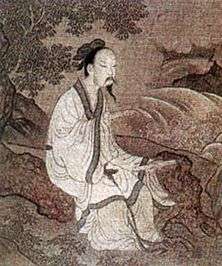 Trần Thái Tông Founder Emperor of the Trần Dynasty (1225–1400) of Vietnam.
Trần Thái Tông Founder Emperor of the Trần Dynasty (1225–1400) of Vietnam.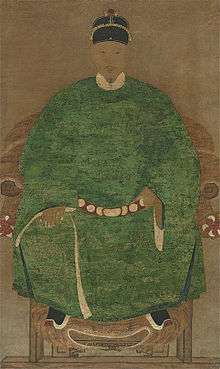 Koxinga, the Southern Ming loyalist who resisted the Qing Empire.
Koxinga, the Southern Ming loyalist who resisted the Qing Empire.
- Empress Dowager Huang, also known as Empress Dowager Longqi (龍啟太后) after her son Wang Yanjun's 'Longqi' era name, was an Empress Dowager and later was the Grand Empress Dowager of the State of Min during the Chinese Five Dynasties and Ten Kingdoms period .
- Lý Thái Tổ (birth name :Lý Công Uẩn), Founder Emperor of the Lý Dynasty (1009–1225) of Vietnam. He is generally viewed as the founder of the city of Hà Nội.
- Trần Thái Tông (birth name: Trần Cảnh), Founder Emperor of the Trần Dynasty (1225–1400) of Vietnam.
- Queen Sri Suriyendra, Queen consort of King Rama II of Siam in the early 19th Century, mother of King Mongkut, Vice King Pinklao and grandmother of King Chulalongkorn.
- Koxinga or Zheng Chenggong, Founder of the short lived Kingdom of Tungning in the mid 17th Century. He was a Chinese Ming Dynasty loyalist who resisted the Qing conquest of China in the 17th century, fighting them on China's southeastern coast.
- Ong Sum Ping married Princess Ratna Dewi, the daughter of Sultan Muhammad Shah of Brunei. As a royal son in law, he was conferred the nobility title of Pengiran Maharaja Lela and elected Chief of Kinabatangan in the 14th Century.
Politicians and Public Office
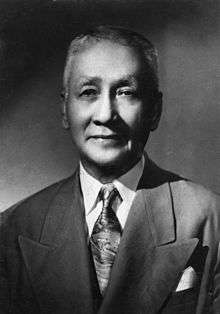
 Corazon Aquino, 11th President of the Philippines.
Corazon Aquino, 11th President of the Philippines.
- Zhang Gaoli, Formerly first-ranked Vice Premier of the People's Republic of China. He served as a member of the Politburo Standing Committee, China's highest ruling council 2012 - 2017.
- Li Guangdi, Famous Qing dynasty Chancellor, Grand Secretary, Governor, Scholar and Writer. He is credited with the planning to defeat the Revolt of the Three Feudatories, Pacification of Fujian and of Shi Lang's conquest of Taiwan. He has also written and edited a number of important philosophical texts.
- Sergio Osmeña Sr. 4th President of the Philippines, son of Go Bon Tiao or Pedro Lee Gotiaoco. [16]
- Corazon Aquino, 11th President of the Philippines whose maiden name Cojuangco derived from her ancestor, Co Yu Hwan (許玉寰/Jose Cojuangco) who migrated from Fujian Province in 1861.
- Phan Thanh Giản Grand Counsellor of the Nguyễn Dynasty in Vietnam in the 19th Century.
- Wee Kim Wee 4th President of Singapore (1985-1993). Former journalist and Diplomat.
- Ong Teng Cheong, 5th President of Singapore and former Deputy Prime Minister of Singapore.
- Tony Tan Keng Yam, 7th President of Singapore (2011-2017) and former Deputy Prime Minister of Singapore.
- Chuan Leekpai, 20th Prime Minister of Thailand. He served twice as Prime Minister of Thailand .
- Phraya Ratsadanupradit Mahitsaraphakdi or Khaw Sim Bee, Siam born Provincial Governor of Ranong, Trang and Commissioner of Monthon Phuket during the late 19th and early 20th Century. His most significant contribution was the introduction of the rubber tree to Thailand. In 1992, he was also honored as one of the five most distinguished Thai government officials in administration.
- Kittiratt Na-Ranong, Deputy Prime Minister of Thailand 2011-2014. Great grand nephew of Phraya Ratsadanupradit Mahitsaraphakdi
- Goh Keng Swee, Hailed as the “economic and nation building architect” of Singapore. One of the key founding fathers of modern Singapore. Former 2nd Deputy Prime Minister, Ministers for Finance, Interior and Defence, Education and Defence.
- Goh Chok Tong, 2nd Prime Minister of Singapore.[17]
- Wee Chong Jin, The first Chief Justice of the Republic of Singapore. Born in Penang, Malaya he was the first Asian lawyer to be appointed a judge at the Supreme Court of Singapore. He served in the position of Chief Justice for 27 years, making him the longest-serving chief justice in the Commonwealth.
- Professor Tommy Koh, Ambassador-at-Large for the Government of Singapore. He was President of the Third United Nations Conference on the Law of the Sea, 1980–1982, successfully negotiated in getting the Convention passed.
- Tan Cheng Lock, one of the key founding fathers of modern-day Malaysia and founder president of the Malaysian Chinese Association (The only Ethnic Chinese Political Party and 2nd largest political party in pre and post independence Malaysia)
- Tan Chee Khoon Leader of the Opposition of Malaysia Parliament 1964-1979.
- Lim Kit Siang Longest serving Leader of the Opposition of Malaysia 1973-1974, 1975-1999, 2004-2008 and father of Lim Guan Eng.
- Dr.Lim Chong Eu former Chief Minister of the Malaysian State of Penang (1969-1990).
- Lim Guan Eng 17th Minister of Finance of Malaysia, former Chief Minister of the Malaysian State of Penang (2008-2018).
- Souw Beng Kong, The 1st Kapitein der Chinezen of Batavia (present day Jakarta) 1619–1636. Appointed by the ruling Dutch East Indies when the Dutch headquarters was moved from Banten to the newly conquered city of Jayakarta (later renamed Batavia), This was the highest-ranking Chinese position in the civil administration of the Dutch East Indies. Beyond his role as Kapitein, Souw Beng Koen was also given the authority to mint coins and print money in Batavia. He also developed trade links between Dutch Formosa (Taiwan) and Batavia towards the end of the Ming Dynasty.
- Tan Eng Goan was a high-ranking bureaucrat who served as the 1st Majoor der Chinezen of Batavia (now Jakarta), capital of colonial Indonesia -1837–1865. This was the highest-ranking Chinese position in the civil administration of the Dutch East Indies.
- Han Siong Kong Founder of the Han family of Lasem, Dutch East Indies, a dynasty of government bureaucrats and landlords that played an important role in the colonial Dutch East Indies of history of Indonesia.
- Loa Sek Hie : Indonesian-Chinese colonial politician, parliamentarian and founding Voorzitter or chairman of the ethnic-Chinese self-defense force Pao An Tui (1946 - 1949) before the formation of modern day Indonesia.
- Kwik Kian Gie, the Indonesian Coordinating Minister of Economics and Finance (1999–2000).
- Mari Elka Pangestu (Phang Hoei Lan), the Minister of Trade of Indonesia (2004-2011).
- Lim Yew Hock, 2nd Chief Minister of Singapore from 1956 to 1959 when it was a British Colony.
- Tan Yu Sai, one of the founding members of the Union Revolutionary Council of Burma 1962 -1970, and Minister for Trade .
- Yeoh Eng-kiong, Secretary for Health, Welfare and Food of Hong Kong 1999-2004. (Malaysian born)
- Chen Shui-bian, 5th President of the Republic of China (Taiwan).
- Vincent Siew, Vice President of Republic of China (Taiwan) from 2008 to 2012 and Premier of the Republic of China (Taiwan) 1997 to 2000.
- Wu Den-yih, Vice President of Republic of China (Taiwan) from 2012 to 2016 and Premier of the Republic of China (Taiwan) 2009 to 2012.
- Koo Chen-fu, Taiwanese businessman and diplomat. As a chairman of the Straits Exchange Foundation (SEF), Koo arranged the first direct talks between Taiwan and mainland China since 1949 and served as Taiwan's negotiator in both the 1993 and 1998 Wang-Koo summit.
Military and Security
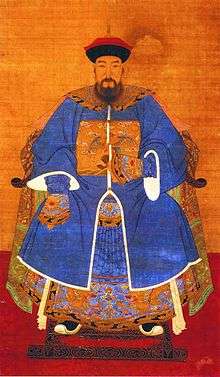
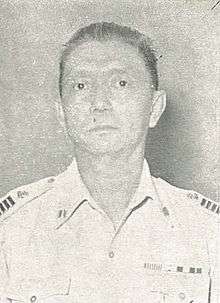 John Lie Tjeng Tjoan , National Hero of Indonesia. He was one of the first high-ranking naval commanders during the Indonesian National Revolution.
John Lie Tjeng Tjoan , National Hero of Indonesia. He was one of the first high-ranking naval commanders during the Indonesian National Revolution. Vicente Lim, Filipino warhero who fought and died against the Japanese army during the Second World War
Vicente Lim, Filipino warhero who fought and died against the Japanese army during the Second World War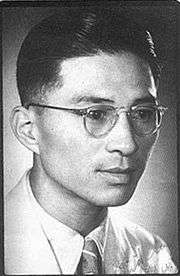 Lim Bo Seng, Fujian born patriot and war hero who was caught and tortured by the invading Japanese army in British Malaya.
Lim Bo Seng, Fujian born patriot and war hero who was caught and tortured by the invading Japanese army in British Malaya.
- Yu Dayou, Ming dynasty General best known for countering the wokou pirates along China's southeastern coast during the reign of the Jiajing Emperor. He was also a famous martial arts exponent.
- Yu Zigao, Ming Dynasty Military Governor of Fujian and Zhejiang who drove away the Dutch forces from Penghu Islands (Pescadores). He is the son of Yu Dayou.
- Hong Chengchou, A General during the Ming Dynasty and Qing Dynasty. He was promoted to Minister of War and Viceroy of Suliao during the late Ming Dynasty.
- Shi Lang, Commander-in-chief of the Qing dynasty fleets which defeated the Kingdom of Tungning and conquered Taiwan for the Qing dynasty in 1683.
- José Ignacio Paua or Hou Yabao , a general who participated in the 1896 Philippine Revolution against the Spanish Empire and the Philippine-American War in 1898.
- Huang Sian Teh, Army general of the KMT Chinese Nationalist Army during World War II, he was in charge of the "Tiger Division", which fought in over 100 battles. A famous Shaolin martial arts instructor, he was elected Chairman of the Taipei Chinese Kung Fu Association in 1967.
- John Lie Tjeng Tjoan or Jahja Daniel Dharma, National Hero of Indonesia. He was one of the first high-ranking naval commanders during the Indonesian National Revolution.
- Vicente Lim, Brigadier General, Commanding General of the 41st Infantry Division, Philippine Army (USAFFE) and hero during World War II. Lim was the first Filipino graduate of the United States Military Academy at West Point (Class of 1914) and one of the seven Charter Members of the Boy Scouts of the Philippines. He was memorialized in the Philippines' 1,000-Peso banknote together with two other Filipino heroes who fought and died against the Japanese during the Second World War.
- Major General Lim Bo Seng, Chinese patriot and war hero. When the Second Sino-Japanese War broke out, Lim and other Chinese in Singapore participated in anti-Japanese activities such as the boycotting of Japanese goods and fund-raising to support China in the war.
- Khoo Boon Hui served as President of INTERPOL from 2008 to 2012. He was formerly the Commissioner of the Singapore Police from July 1997 to January 2010
Philosophers and Writers
- Li Zhi (philosopher), Chinese philosopher, historian and writer of the late Ming Dynasty
- Jose Rizal a writer and one of the national heroes of the Philippines, a descendant of Cue Yi-Lam or Domingo Lamco.
- Lin Yutang, one of the most influential writers of his generation, many of his books were bestsellers both in China and the Western world.
- Amy Chua, American Professor of Law and author of the international best seller Battle Hymn of the Tiger Mother which attracted huge media attention and ignited global debate about different parenting techniques and cultural attitudes that foster such techniques. Daughter of Leon O. Chua.
Sportspeople
- Jeremy Lin, an American professional basketball player for the Brooklyn Nets of the NBA
- Rudy Hartono, Indonesian badminton player who was one of the greatest badminton players of all time.
- Lin Dan, a professional badminton player from Fujian. He is a two-time Olympic champion, five-time World champion, as well as a six-time and reigning All England champion.
- Lee Chong Wei, a Malaysian professional badminton player, who is the most successful Malaysian Olympian in history.
- Koo Kien Keat, a former Malaysian professional badminton player.
- Liem Swie King, former Indonesian badminton player
- Christian Hadinata, former Indonesian badminton player
- Eric Go, American Badminton player
- Ong Poh Lim, a badminton player who won numerous national and international titles from the late 1940s to the early 1960s. Known for his quickness and his aggressive, unorthodox playing style
- Tan Boon Heong, a former World No.1 Malaysian male professional badminton player in the men's doubles event.
- Hoon Thien How, a professional badminton player from Malaysia
- Ang Peng Siong, is a swimmer from Singapore, who once held World Number 1 ranking in the 50 m freestyle.
- Michael Chang, an American former tennis player.
- Chen Haiwei, a Chinese competitive fencer. He has won three medals (one gold, one silver, one bronze) at the Asian Fencing Championships
Martial Artists
- Chee Kim Thong, famous practitioner of Five Ancestors Fist
- Fang Qi Niang, inventor of the White Crane Style, a style of Shaolin boxing
- Yu Dayou, Chinese general and martial artist best known for countering the wokou pirates in the Ming Dynasty
Entertainers
- Dick Lee, a Singaporean pop singer, composer and playwright.
- Yao Chen, a Chinese actress whom Forbes ranks as the 83rd most powerful woman in the world
- Wu Bai, is a Taiwanese rock singer and songwriter.
- Jody Chiang, is Taiwan's most famous singer and is often referred to as the Queen of Taiwanese pop music.
- Teresa Teng, was a Taiwanese pop singer. She was known for her folk songs and romantic ballads. She recorded songs in Hokkien, Mandarin, Cantonese, Japanese, Indonesian and English.
- Janet Hsieh, a Taiwanese-American television personality, violinist, author, and model based in Taipei, Taiwan. She is most well known for playing the Taiwanese Mandarin voiceover of Anna in the movie Frozen.
- Han Kuo-Huang, a Chinese-born American musician.
- Katrina Law, an American actress. She is known for playing the roles of Mira in the Starz television series, Spartacus: Blood and Sand and Spartacus: Vengeance, and Nyssa al Ghul on The CW television series, Arrow.
- George Hu, is an American actor and singer based in Taiwan. He speaks fluent Taiwanese, Mandarin, and English.
- Rebecca Lim, a Singaporean actress who has acted in several English and Chinese dramas
- Jack Neo, a Singaporean film and television actor, host and director.
- Joshua Ang, Singaporean actor
- Ah Niu, a Malaysian Chinese singer in Malaysia and Singapore
- Michelle Yeoh, a Chinese Malaysian actress, best known for performing her own stunts in the Hong Kong action films that brought her to fame in the early 1990s.
- Sarah Lian, a Chinese Malaysian actress and television personality based in Kuala Lumpur, Malaysia.
- Lim Kay Tong, Singaporean actor
- Sharon Au, former Singaporean actress and host
- Priscelia Chan, Singaporean television actress
- Chen Guohua (actor), Singaporean actor
- Joi Chua, Singaporean pop singer
- Edmund Chen, Singaporean actor
- Paige Chua, Singaporean model and actress
- Baiyu (singer), Chinese-born American singer-songwriter and actress.
Artists
- Lim Hak Tai, Singapore's pioneer artist at the turn of the 20th century, and was the person who inspired the Nanyang School of art form
- Cheong Soo Pieng, a Singaporean artist who was a pioneer of the Nanyang art style
- Liu Kang, Singaporean artist known for his Balinese-themed paintings
- Tan Swie Hian, artist known for his contemporary sculptures and Chinese calligraphy
- Cai Guo-Qiang, Chinese contemporary artist who works in New York. Much of his work draws on Maoist/Socialist concepts.
Other Fields
- Baosheng Dadi, Song Dynasty doctor and Taoist practitioner who was credited with performing medical miracles. After his death, he was worshiped as a deity.
- Lorenzo Ruiz, first Filipino saint. He became the Philippines' protomartyr after his execution in Japan by the Tokugawa Shogunate during its persecution of Japanese Christians in the 17th century.
- Stephen Tong Tjong Eng, Chinese Indonesian Reformed pastor, international evangelist, Bible teacher and musician. He heads the Reformed Evangelical Church of Indonesia, which houses the megachurch Messiah Cathedral, and is one of the largest Christian Reformed church facilities in Southeast Asia.
- Rudy Hartono Legendary badminton player from Indonesia. Won the men's singles title at the prestigious All-England Championship a total of eight times with seven times consecutively (1968–1974) and at World Championship in 1980.
- Liem Swie King also known as "King Smash". Played and won major badminton titles for Indonesia during the 70's and 80's. 3 times All England Champion.
- Ko Chun-hsiung famous Taiwanese actor, director and politician. Winner of three Golden Horse Awards, two Asia Pacific Film Festival Awards for Best Actor, a Panama International Film Festival Award for Best Actor.
- Wesley So, famous chess prodigy, he won the 2015 Bilbao Chess Masters and 2016 Sinquefield Cup.
- Michelle Yeoh, famous international movie star from Malaysia. Voted by People magazine as one of the "35 All-Time Screen Beauties"—the only Asian actress to make the list.
See also
References
- ↑ "Han Chinese, Hokkien in Malaysia". Joshuaproject.net. Retrieved 2 June 2018.
- ↑ Ng, Maria; Philip Holden (1 September 2006). Reading Chinese transnationalisms: society, literature, film. Hong Kong University Press. p. 20. ISBN 978-962-209-796-4.
- ↑ Lewis, M. Paul, ed. (2005), "Indonesia", Ethnologue: Languages of the World (15th ed.), Dallas, T.X.: SIL International, ISBN 978-1-55671-159-6, retrieved 26 January 2010.
- ↑ Mya Than (1997). Leo Suryadinata, ed. Ethnic Chinese As Southeast Asians. ISBN 0-312-17576-0.
- ↑ 2005-2009 American Community Survey
- ↑ Ben Sia, 《新加坡的漢語方言》 (The Chinese Languages and Dialects of Singapore),1988
- ↑ Gu Yanwu (1985). 《天下郡國利病書》:郭造卿《防閩山寇議》. 上海書店. OCLC 19398998.
漳猺人與虔汀潮循接壤處....常稱城邑人為河老,謂自河南遷來畏之,繇陳元光將卒始也
- ↑ Exec. Yuan (2014), pp. 36,48.
- ↑ Exec. Yuan (2015), p. 10.
- ↑ Governor-General of Taiwan (1931–1932). "hô-ló (福佬)". In Ogawa Naoyoshi. 臺日大辭典 [Taiwanese-Japanese Dictionary] (in Japanese and Hokkien). 2. Taihoku: 同府 [Dōfu]. p. 829. OCLC 25747241. .
- ↑ Kane, Daniel (2006). The Chinese language: its history and current usage. Tuttle Publishing. pp. 100–102. ISBN 978-0-8048-3853-5.
- ↑ Davidson (1903), p. 591.
- ↑ Yu, Henry, edited by Tan, Chee-Beng, Routledge Handbook of the Chinese Diaspora p. 110
- ↑ "Xie Xide" A talented female physicist". Xiamen University. 2012.
- ↑ 李遠哲
- ↑ "Pedro Singson Gotiaoco". Geni_family_tree. Retrieved 2 June 2018.
- ↑ "吴作栋] 新加坡前总理吴作栋盛赞千岛湖开元". Baike.baidu.com. Retrieved 2 June 2018.
Bibliography
- Brown, Melissa J (2004). Is Taiwan Chinese? : The Impact of Culture, Power and Migration on Changing Identities. Berkeley: University of California Press. ISBN 0-520-23182-1.
- Davidson, James W. (1903). The Island of Formosa, Past and Present. London and New York: Macmillan. OCLC 1887893. OL 6931635M.
- The Republic of China Yearbook 2014 (PDF). Executive Yuan, R.O.C. 2014. ISBN 9789860423020. Retrieved 2016-06-11.
- The Republic of China Yearbook 2015. Executive Yuan, R.O.C. 2015. ISBN 9789860460131.